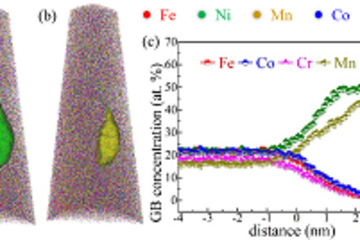All genres
21.
Journal Article
Influence of supersaturated carbon on the diffusion of Ni in ferrite determined by atom probe tomography. Scripta Materialia 69 (5), pp. 424 - 427 (2013)
22.
Journal Article
Atomic scale investigation of redistribution of alloying elements in pearlitic steel wires upon cold-drawing and annealing. Ultramicroscopy 132, pp. 233 - 238 (2013)
23.
Journal Article
Nanocrystalline Fe–C alloys produced by ball milling of iron and graphite. Acta Materialia 61 (9), pp. 3172 - 3185 (2013)
24.
Journal Article
Evolution of strength and microstructure during annealing of heavily cold-drawn 6.3 GPa hypereutectoid pearlitic steel wire. Acta Materialia 60, pp. 4005 - 4016 (2012)
25.
Journal Article
Atomic-scale mechanisms of deformation-induced cementite decomposition in pearlite. Acta Materialia 59 (10), pp. 3965 - 3977 (2011)
26.
Journal Article
Atom Probe Tomography characterization of heavily cold drawn pearlitic steel wire. Ultramicroscopy 111 (6), pp. 628 - 632 (2011)
27.
Journal Article
Microstructure and texture evolution in dual-phase steels: Competition between recovery, recrystallization, and phase transformation. Materials Science and Engineering A 527 (16-17), pp. 4161 - 4168 (2010)
28.
Journal Article
Stability of ultrafine-grained Cu to subgrain coarsening and recrystallization in annealing and deformation at elevated temperatures. Acta Materialia 57, pp. 5207 - 5217 (2009)
29.
Book Chapter
Interface segregation in advanced steels studied at the atomic scale. In: Microstructural Design of Advanced Engineering Materials, pp. 267 - 298 (Ed. Molodov, D. A.). Wiley-VCH Verlag GmbH & Co. KGaA, Weinheim, Germany (2013)
30.
Conference Paper
On the Multiple Event Detection in Atom Probe Tomography. In: MicroscopyMicroanalysis, Vol. 23, pp. 618 - 619. Microscopy & Microanalysis 2017, St. Louis, MO, USA, August 06, 2017 - August 10, 2017. (2017)
31.
Conference Paper
Metallic composites processed via extreme deformation: Toward the limits of strength in bulk materials. MRS Bulletin 35, pp. 982 - 991 (2010)
32.
Talk
Moving cracks and missing C atoms – chasing the mysteries of white etching areas in bearings. 2nd meeting of "Metallurgical Metallurgy for Plasticity-driven Damage and Fracture" research forum 2021 (ISIJ), virtual (2021)
33.
Talk
Moving cracks form white etching areas during rolling contact fatigue in bearings. MSE 2020: Conference takes place exclusively over the Internet (2020)
34.
Talk
The role of carbon in the formation of white etching cracks. Thermes 2018 Annual Meeting & Exhibition, Paris, France (2018)
35.
Talk
Where does the carbon atom go in steel? – Insights gained by correlative transmission electron microscopy and atom probe tomography. International Symposium on Steel Science 2017, Kyoto, Japan (2017)
36.
Talk
Materials for energy generation probed at the nanoscale. European Energy Resarch Alliance Conference 2016, EERA, Birmingham, UK (2016)
37.
Talk
Unexpected Stress Induced Martensite Formation in Ultra-strong Pearlitic Steel. 2016 TMS Annual Meeting & Exhibition, Symposium: Advanced Characterization Techniques for Quantifying and Modeling Deformation
, Nashville, TN, USA (2016)
38.
Talk
Transformation de phase induite par déformation plastique sévère des aciers perlitiques. XIe Colloque Rayons X & Matière, Grenoble, France (2015)
39.
Talk
Deformation-driven phase transition in severely cold-deformation pearlitic steel. General Meeting on the Mechanics of Nano-Objects, Marseille, France (2015)
40.
Talk
Supersaturated ferrite in severely cold-drawn pearlitic steel - X-ray diffraction study. Pearlite Workshop, MPI für Eisenforschung GmbH, Düsseldorf, Germany (2015)











